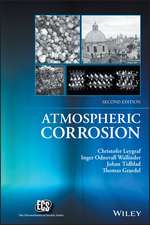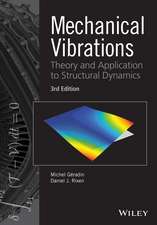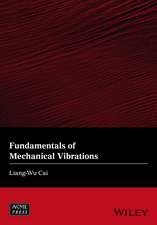Characterisation of Porous Solids VIII: Special Publication
Editat de Nigel Seaton, Francisco Rodriguez Reinoso, Philip Llewellyn, Stefan Kaskellen Limba Engleză Hardback – 27 feb 2009
This unique book is the Proceedings of the 8th International Symposium on the Characterisation of Porous Solids, known also as "COPS VIII". The conference is one of a series, held every three years, which covers developments in methods for the characterisation of porous materials, and applications of those methods. The scope of the conference: COPS VIII is concerned with fundamental and applied research on the characterisation of the structure of porous materials, and the relationship between structure and material performance. The scope includes experimental characterisation methods such as X-Ray diffraction, NMR, adsorption, mercury intrusion, and calorimetry; theoretical and simulation methods used to interpret experimental data, such as molecular simulation, classical and statistical mechanical theory, and pore network modelling; and applied research on the impact of measured material properties on performance in applications.
Din seria Special Publication
-
 Preț: 119.56 lei
Preț: 119.56 lei - 14%
 Preț: 930.39 lei
Preț: 930.39 lei - 14%
 Preț: 848.24 lei
Preț: 848.24 lei - 14%
 Preț: 772.72 lei
Preț: 772.72 lei - 14%
 Preț: 929.22 lei
Preț: 929.22 lei - 14%
 Preț: 939.67 lei
Preț: 939.67 lei - 14%
 Preț: 782.17 lei
Preț: 782.17 lei - 14%
 Preț: 1062.13 lei
Preț: 1062.13 lei - 14%
 Preț: 934.04 lei
Preț: 934.04 lei - 11%
 Preț: 654.19 lei
Preț: 654.19 lei - 14%
 Preț: 832.20 lei
Preț: 832.20 lei - 14%
 Preț: 853.71 lei
Preț: 853.71 lei - 11%
 Preț: 644.94 lei
Preț: 644.94 lei - 11%
 Preț: 648.03 lei
Preț: 648.03 lei - 14%
 Preț: 936.01 lei
Preț: 936.01 lei - 14%
 Preț: 932.36 lei
Preț: 932.36 lei - 14%
 Preț: 780.35 lei
Preț: 780.35 lei - 14%
 Preț: 782.83 lei
Preț: 782.83 lei - 11%
 Preț: 646.49 lei
Preț: 646.49 lei - 14%
 Preț: 775.53 lei
Preț: 775.53 lei - 14%
 Preț: 923.94 lei
Preț: 923.94 lei - 14%
 Preț: 790.28 lei
Preț: 790.28 lei - 14%
 Preț: 784.15 lei
Preț: 784.15 lei - 27%
 Preț: 2137.96 lei
Preț: 2137.96 lei - 11%
 Preț: 689.47 lei
Preț: 689.47 lei - 14%
 Preț: 778.71 lei
Preț: 778.71 lei - 14%
 Preț: 782.31 lei
Preț: 782.31 lei - 14%
 Preț: 944.44 lei
Preț: 944.44 lei - 11%
 Preț: 611.33 lei
Preț: 611.33 lei - 14%
 Preț: 776.37 lei
Preț: 776.37 lei - 14%
 Preț: 922.77 lei
Preț: 922.77 lei - 14%
 Preț: 778.02 lei
Preț: 778.02 lei - 11%
 Preț: 583.29 lei
Preț: 583.29 lei - 11%
 Preț: 653.17 lei
Preț: 653.17 lei - 5%
 Preț: 862.02 lei
Preț: 862.02 lei - 14%
 Preț: 773.13 lei
Preț: 773.13 lei - 14%
 Preț: 859.18 lei
Preț: 859.18 lei - 11%
 Preț: 657.77 lei
Preț: 657.77 lei - 14%
 Preț: 948.75 lei
Preț: 948.75 lei - 14%
 Preț: 786.15 lei
Preț: 786.15 lei - 14%
 Preț: 942.81 lei
Preț: 942.81 lei - 14%
 Preț: 857.37 lei
Preț: 857.37 lei - 14%
 Preț: 797.79 lei
Preț: 797.79 lei - 14%
 Preț: 960.02 lei
Preț: 960.02 lei - 14%
 Preț: 893.30 lei
Preț: 893.30 lei - 11%
 Preț: 681.43 lei
Preț: 681.43 lei - 14%
 Preț: 798.03 lei
Preț: 798.03 lei
Preț: 940.46 lei
Preț vechi: 1093.56 lei
-14% Nou
Puncte Express: 1411
Preț estimativ în valută:
179.98€ • 187.21$ • 148.58£
179.98€ • 187.21$ • 148.58£
Carte tipărită la comandă
Livrare economică 14-28 aprilie
Preluare comenzi: 021 569.72.76
Specificații
ISBN-13: 9781847559043
ISBN-10: 1847559042
Pagini: 446
Ilustrații: 1, black & white illustrations
Dimensiuni: 160 x 234 x 30 mm
Greutate: 0.82 kg
Editura: Royal Society Of Chemistry
Seria Special Publication
Locul publicării:United Kingdom
ISBN-10: 1847559042
Pagini: 446
Ilustrații: 1, black & white illustrations
Dimensiuni: 160 x 234 x 30 mm
Greutate: 0.82 kg
Editura: Royal Society Of Chemistry
Seria Special Publication
Locul publicării:United Kingdom
Cuprins
Chapter 1: Pore accessibility in nanoporous carbons: experiment, theory and simulation ; Chapter 2: Characterization Measurements of Common Reference Nanoporous Materials by Gas Adsorption (Round Robin Tests); Chapter 3: Competitive naphthalene adsorption on activated carbons: effect of porosity and hydrophobicity; Chapter 4: Study of Hydrogen Sulphide Adsorption on MIL-47(V) and MIL-53(Al, Cr, Fe) Metal-Organic Frameworks by Isotherms Measurements and in-situ IR Experiments; Chapter 5: H2 Adsorption in Pristine and Li-Doped Carbon Replicas of FAU and EMT Zeolites; Chapter 6: Comparative Analysis of Low-Temperature Nitrogen and Argon Adsorption on Nonporous and Mesoporous Siliceous Materials; Chapter 7: Characterization of Microporous Carbons: From Mathematical Modeling to Atomistic Construction; Chapter 8: Hybrid Reverse Monte Carlo Simulations of Microporous Carbons; Chapter 9: Can Chemometrics Provide Useful Data About Porous Solids Characterization?; Chapter 10: Origin of the Variation of Adsorption and Diffusion Properties of Zeolite 5A; Chapter 11: Assessing Generic Force Fields to Describe Adsorption on Metal-organic Frameworks; Chapter 12: A Method for Predicting the Diffusion Coefficient Based on the Physical Characterisation of Porous Carbons by Adsorption; Chapter 13: Positron Lifetime Spectroscopy on Controlled Pore Glass; Chapter 14: Dynamic Mean Field Theory for Fluids Confined in Porous Materials: Application to an Inkbottle Pore Geometry; Chapter 15: Characterization of Single Wall Carbon Nanohorns Restructured with Mechanical Treatment; Chapter 16: Adsorption Characterisation of Energy Gases on Microporous Coordination Polymers; Chapter 17: Post-Synthesis Modification of a Metal-Organic Framework with Silver Ions; Chapter 18: Optimizing H2 volumetric storage capacity of carbon materials for mobile applications; Chapter 19: Tailoring carbon gels for their use in the energy sector; Chapter 20: Investigation on the structure of silica/polyurethane nanocomposites; Chapter 21: Narrow microporosity characterization in polyaramid-derived carbons by adsorption of N2, CO2 and organic vapors; Chapter 22: Monoliths: Synthesis and Characterization Using Lignocellulosic Precursor; Chapter 23: Microporosity of activated carbons obtained from PET; Chapter 24: Low Pressure Hysteresis in the Nitrogen Adsorption Isotherm of ZSM-5: Effect of Acid Treatment; Chapter 26: In species and structural properties of In-exchanged ZSM5 and Mordenite; Chapter 27: The Properties of Virtual Solids using Monte Carlo Integration and their Value to the Nano-Scientist; Chapter 28: Computer Simulation of Enantioselective Adsorption in a Simple Model of Molecularly Imprinted Polymers; Chapter 29: Mixed Geometry Characterization of Activated Carbons PSD; Chapter 30: Modified BET equation for determination of micropore pore-volume and mesopore surface area in microporous-mesoporous solids; Chapter 31: Characterisation of Nanostructured macro-mesoporous TiO2-ZrO2 impregnated by noble metals for VOC oxidation; Chapter 32: Visualisation of dynamic adsorption by 2D x-ray radiography and 3D x-ray -tomography; Chapter 33: Supercritical Methane Adsorption - A Tool For Characterization of Carbonaceous Adsorbents; Chapter 34: The Adsorption of Triacetin on Activated Carbon; Chapter 35: Adsorption of CO2 on Carbonaceous Adsorbents; Chapter 36: Characterization of Various Micro and Mesoporous Materials for Toluene Adsorption at Low and High Concentration; Chapter 37: Computer assisted design of porous solids for VOCs emission control by adsorption in vehicle cold start; Chapter 38: The use of silica-alumina mixed oxides with well defined surface characteristics and porosities for the transformation of renewable feedstocks into value added chemicals; Chapter 39: Designing (Al-)SBA-15 catalyst pellets with unique properties; Chapter 40: Capillary Condensation and Sorption Hysteresis of Toluene, Methylcyclohexane and Neopentane on MCM-41 and MCM-48; Chapter 41: Pore Structure and Morphology of Mesoporous Silicate and Aluminosilicate Molecular Sieves by Nitrogen Adsorption, AFM and PALS; Chapter 42: Transport in SiO2-Catalyst Supports: A Contribution to Process Intensification; Chapter 43: Surface, Acidic and Catalytic Properties of Sulfated Titanium Oxides; Chapter 44: A Comparative Study of Sulfated and Phosphated Titanium Oxides Prepared by Hydrolysis From Titanium Ethoxide; Chapter 45: Correlation of Surface Texture, Catalytic Activity and Crystal Morphology for Ternary Mixed Metal Oxides; Chapter 46: Synthesis and Characterization of Al/Ce Incorporated Mesoporous Molecular Sieves; Chapter 47: Surface nature and structure of limestone powder - evaluation of properties using sorption and standard techniques; Chapter 48: Investigation of the microstructure of ultra high performance concrete; Chapter 49: Determination of Surface Area, Porosity and Surface Properties of Lunar Regolith; Chapter 50: The use of starch-based biopolymer additives ffffffor the preparation of porous ceramics; Chapter 51: Iron Fixation to the Fibers of Activated Carbon as an Alternative to the Fenton Process; Chapter 52: A Relationship Between Pore Shapes and Mercury Porosimetry Curves as Revealed by Random Pore Networks; Chapter 53: Physicochemical characterization of nanostructured tungsten oxide: porous clusters and nanowires; Chapter 54; Positron Porosimetry Study of Mechanical Stability of Ordered Mesoporous Materials; Chapter 55: Characterisation of modified porous silica by inverse gas chromatography; Chapter 56: Structural distinction of silica gels using FTIR and Raman spectroscopy; Chapter 57: The Poisson ratio of porous materials
Notă biografică
This book is the proceedings of the 8th International Symposium on the Characterisation of Porous Solids that took place in Edinburgh, 10-13th June 2008
Descriere
This book is the proceedings of the 8th International Symposium on the Characterisation of Porous Solids that took place in Edinburgh, 10-13th June 2008.







